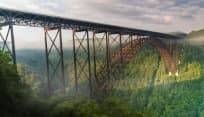Traversing the Mon: 9 must-see sites in WV’s massive national forest
The Monongahela National Forest: nearly 1 million acres of breathtaking scenery and mountain recreation.
The woodland wonderland covers the north central highlands of West Virginia. More than 1 million visitors a year tuck away into the Mon’s 23 campgrounds, 800-plus miles of trails and numerous lakes and rivers. The remote landscape is an ideal place for hiking, biking, horseback riding, hunting, fishing, boating, tubing and rock climbing.
Here are 9 great places in this vast wilderness every outdoor lover needs to explore in your lifetime:
1. Spruce Knob
Reaching 4,863 feet on the Allegheny Front ridge, Spruce Knob is the highest point in West Virginia— in fact, the highest point in the entire Chesapeake Bay Watershed, which blankets much of the East Coast.
The dense spruce forest gives the area an alpine feel, while a manmade lookout tower offers awe-inspiring views of Germany Valley, North Fork Mountain and the Allegheny Plateau.

2. Seneca Rocks
One of the most iconic landmarks in West Virginia, the Tuscarora quartzite fins of Seneca Rocks jutting out from the mountains make this area one of the most popular rock climbing destinations on the East Coast. For the non-climbers, a 1.5-mile trail hiking trail winds around the mountain to the summit.
During World War II, Seneca Rocks was a training ground for the 10th Mountain Division. Learn more about their intensive wilderness assault training school at the Seneca Rocks Discovery Center.
3. North Fork Mountain
The quartzite-capped ridge of North Fork Mountain offers stunning views of Germany Valley and Smoke Hole Canyon, as well as a unique perspective of the back side of Seneca Rocks.
The best way to reach those gorgeous views? Along 24-mile-long North Fork Mountain Trail, which follows the ridge line. It has several entrance points in case you don’t want to hike the entire stretch. Bring plenty of water — there’s none along the trail!
4. Smoke Hole Canyon
Some say Smoke Hole Canyon got its name from the misty fog that rolls along the river. Others claim it was named for the smoke coming from moonshiners’ stills, or from of caves where Native Americans smoked meat. While the name’s source is unclear, most people generally agree that Smoke Hole Canyon is one of the most rugged and beautiful areas in the state. Tucked between North Mountain and Cave Mountain where the South Branch of the Potomac River flows, the canyon is a half-mile deep with nearly vertical walls.

5. Dolly Sods Wilderness
The high-altitude plateau of Dolly Sods is characterized by stunted “flagged” red spruce, wind-carved boulders, heath barrens, grassy meadows and sphagnum bogs– rarely found outside a more northern climate. The remote mountaintop provides habitat for snowshoe hares, beaver, black bear, timber rattlesnakes and white-tailed deer.
During World War II, the U.S. Army used the area as a practice artillery and mortar range, and you can still find some of the shells scattered through the forest. The wilderness was named for an 18th-century German homesteading family (the Dahles), and the local term for an open mountaintop meadow (a “sods.”)
6. Cranberry Glades Botanical Area
The 750 acres of Cranberry Glades make up a unique ecosystem, and the largest area of bogs, or acidic wetlands, in West Virginia. These sphagnum bogs are similar to that found in muskegs (the northern term for bog) of the Arctic tundra.
A wheelchair-accessible boardwalk guides visitors through a landscape of red spruce, yellow birch, hemlocks and more than 60 unique plant species, including wild orchids and carnivorous plants. You might spot signs of wild animals, including black bear, northern flying squirrel, American bald eagle, red fox and white-tailed deer. Learn more about this unique ecosystem at Cranberry Mountain Nature Center.
7. The Falls of Hills Creek
The majestic Falls of Hills Creek consist of 3 levels of waterfalls tucked into a forest lush with rhododendron and strewn with moss-covered boulders. From the top fall to the lowest fall, the creek drops 220 feet.
A wheelchair-accessible path leads to the 25-foot-tall first waterfall. From there, a dirt path and wooden steps take you to the 45-foot-tall second waterfall. Switchbacks and metal steps lead down to the 63-foot-tall third waterfall, where you can rest or take a photo from 2 viewing decks.

8. Highland Scenic Highway
The highest major roadway in the Mountain State, the Highland Scenic Highway, rises from an elevation of 2,300 feet to more than 4,500 feet. 4 scenic overlooks offer spectacular views of the Allegheny Highlands, covered in wildflowers in the spring and bursting with crimson hues in the fall.
9. Williams River
The Williams River’s beautiful setting, easy access and healthy stream habitat make it one of the best trout fishing streams in the state. The river begins on Black Mountain in Pocahontas County and flows 33 miles west to the Gauley River near Cowen in Webster County.
The West Virginia Division of Natural Resources stocks roughly 27,000 pounds of trout from January through May, and again in October. Anglers have to get a National Forest stamp, a trout fishing stamp and a resident or non-resident fishing license before fishing these scenic waters.
What are your favorite places in the Monongahela National Forest?
This post was last updated on December 26, 2024








